My Travels in South East Asia
Laos
China Vietnam Cambodia Laos Thailand
 My Travel in Laos
My Travel in Laos

Hi, Welcome, this is my photo safe deposit.
During
my boat travel from Luang Prabang to Vientiane I fell
overboard in heavy rains and storm.
I became nearly victim of Thuy Tinh, the Maekhong Waterdevil. All my luggage
disappeared in the wild Mekong River. The only good
thing was that I had, due to the bad weather, time in
Luang Prabang to safe my photographs already to a server on the www. So I was forced to make an own web page to
see my photos myself again.
I hope you will feel free to see the pictures of my
travel through South East Asia.

Be careful for my dog. He will bark and bite
you when you do not pay enough attention to my
pictures!
Can you find the the name of the dog?
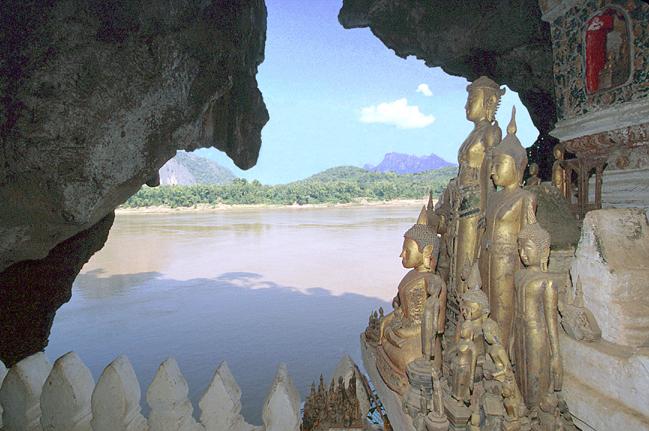
Located in Southeast Asia. If you look at the map you will see that Laos is a "landlocked" country, with no direct access to the sea. In its history this has led to being a buffer country between Thailand (known as Siam) and Vietnam, constantly being invaded and ruled over. At the moment Laos trys to be a "landlink" country and hopes that by building bridges and developing paved roads into Vietnam and China it will see its economy become "linked" to these more prosperous countries. The Lao government wants Laos to become the crossroads of Southeast Asian, finally utilizing its landlocked position to its benefit.
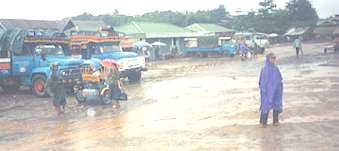
Until 1988, when 500 visitors arrived, Western tourists were not allowed access to Laos, but the country has recently opened up and it is perfectly feasible to travel independently all over the country. Most Laotian monuments are Buddhist, but many structures show the influence of the French upon the country, not least the Monument des Morts in Vientiane which bears a striking, similarity to the Arc de Triomphe in Paris. Visitors will find Vientiane to be an extremely relaxed city for a national capital. 25km from the capital is the stone garden of Xieng Khuane. In the royal palace at Luang Prabang, the former capital of Laos, there is fine artwork, and you can see gifts made to former kings. Nearby, the Phousi in the town centre is a huge rock which visitors can ascend for a panoramic view of the river. Several interesting excursions along the Mekong River are possible from Luang Prabang, including a visit to the Pak Ou Caves where there are a great many statues of Buddha. Wat Xieng Khwan, in Vientiane province near the ferry port to Thailand, has an extraordinary temple.
Laos is bordered on the north by China and Vietnam,
on the east by Vietnam, on the south by Cambodia, on
the west by Thailand, and on the northwest by Myanmar
(Burma). Laos has a boundary issue with Thailand.The total area is 236.800 sq km.
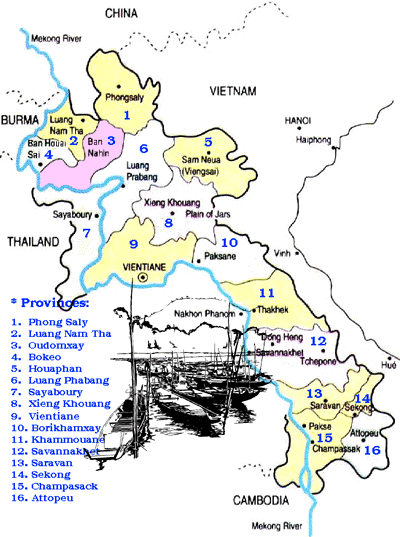
Mountains and plateaus cover well over 70% of the country, more than half of the country is forest and woodland. The Mekong river plays a major role, running a third (1500 km) of it's total lengh through Laos.Today about 5 million people live in Laos. The population density in Laos is very low with only 19 people per sqare kilometer (Germany 246, Great Britain 237, Thailand 120). The county's ethnic mix consists of 68 different minorities. About half the population are Lao Loum (low-land Lao). The three main ethnic groups are distinguished by the height they live at, the time they migrated to Laos and by other cultural and traditional characteristics. The bigger part of the population lives at subsistence level in small villages scattered throughout the country.
Laos has tropical rain forests of broad-leaved evergreens in the north and monsoon forests of mixed evergreens and deciduous trees in the south. In the monsoon forest areas the ground is covered with tall, coarse grass called tranh; the trees are mostly second growth, with an abundance of bamboo, scrub, and wild banana. The forests support a rich wildlife, including elephants, gaurs (wild oxen), deer, bears, tigers and leopards, monkeys, and a large variety of birds.
Laos is predominantly rural and agricultural. The numerous isolated valley communities preserve a variety of different traditions and dialects. Villages usually are located close to rivers and roads that give the people access to itinerant traders as well as to each other. Most villages are laid out around a main street or open area, farmlands being adjacent to the residential areas. Every village, if it can, has a Buddhist temple and supports at least one monk. The temple compound usually includes a public building that serves as a school and a meeting hall. Village leadership is usually divided, the headman having authority in secular matters and the monk in religious.
The chief occupation of the people is agriculture, with the vast majority engaged in rice farming. In years with normal harvests, Laos is self-sufficient in rice production, a reflection of the success of private landownership and market incentives. In addition to a variety of food crops, modest amounts of such cash crops as sugarcane, tobacco, and coffee are produced. Agricultural production, however, is vulnerable to natural calamities, and Laos is subject to periodic droughts and floods, with both sometimes occurring in the same year. A significant proportion of rice production comes from upland dry rice raised by hill people using shifting-cultivation methods (i.e., fields are cleared and cultivated for a few years before being abandoned and allowed to revert to forest). The government has considered this practice to be a major cause of deforestation and has attempted to resettle hill people on plains where they can adopt sedentary agricultural practices.
 The hill people usually are organized on tribal lines and live in smaller groupings. They are hunters and gatherers of forest products, as well as farmers, but their practice of shifting cultivation prevents them from establishing permanent villages. Hill people living close to the lowland areas tend to acquire the languages and cultures of their neighbours and to engage in limited trade with them; those living at higher elevations remain unacculturated.
The hill people usually are organized on tribal lines and live in smaller groupings. They are hunters and gatherers of forest products, as well as farmers, but their practice of shifting cultivation prevents them from establishing permanent villages. Hill people living close to the lowland areas tend to acquire the languages and cultures of their neighbours and to engage in limited trade with them; those living at higher elevations remain unacculturated.
Urban life in Laos is limited mainly to the capital, Vientiane, the former royal capital, Louangphrabang, and four or five other large towns. With the exception of Louangphrabang, all are located in the floodplain area near the Mekong River. Their populations are predominantly Lao, with smaller groups of Chinese, Vietnamese, and Indians. Compared with the cities of Thailand, Malaysia, or Vietnam, those of Laos are small and provincial.
After the borderguard the first visit was the Lao Revolutionary Museum. I am a traveller after all. But this Museum is not a destination for travellers at all. As museums go this is lousy, but fascinating too. There are just a couple of rooms with cabinets holding a few rocks and vases. Then the interesting part begins. Here is the full account, according to the Lao government, of what happened in the 13 or so years up to 1975. Helpfully there are scores of wonderful black and white photos mounted on the walls with captions in both Lao and English. Heroic workers shoot at US planes. Communist Pathet Lao leaders attend important congresses in Hanoi and US imperialist forces carry out 'barbaric' acts. Artefacts include parts of US warplanes shot down, the jackets of communist leaders and most rivettingly, and suitably encased in its own wall cabinet, a communist general's chest expander.
Elephant riding is, perhaps, the most popular
organized attraction in Laos. Several large elephant
camps exist, and the great beasts can often be seen
grazing on surrounding hill sides.These are trained,
working elephants-intelligent, long-lived animals who
readily recognize their mahouts and, guided by
softly-spoken words or the guiding pressure of an
elephant hook, push and pull great teak logs into
easily transportable piles. Not that there is any
logging in Laos itself.
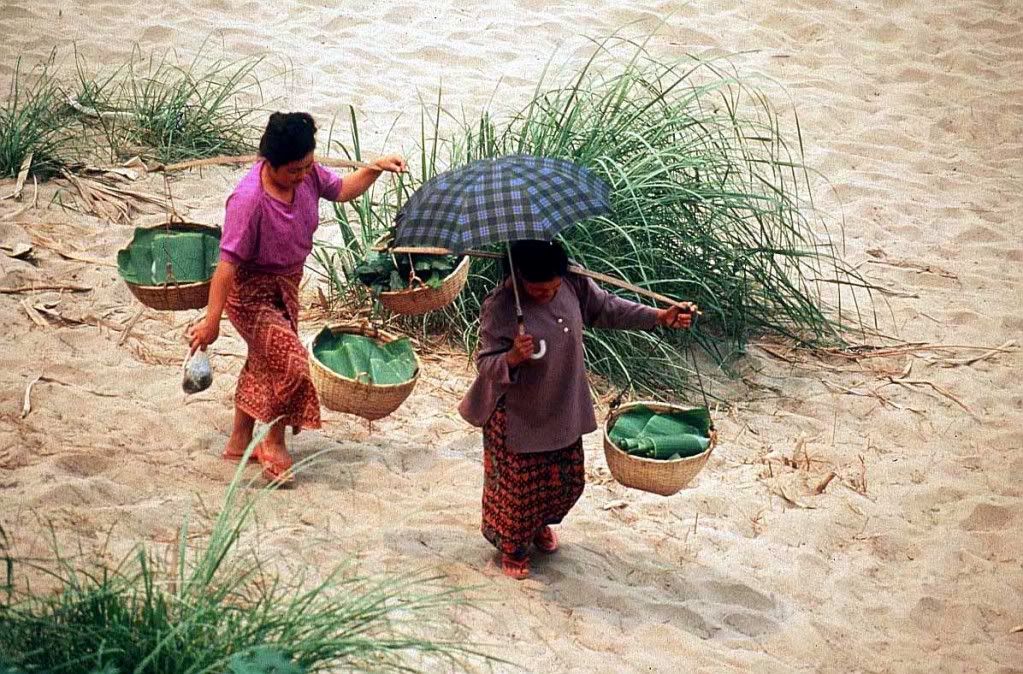 In this region, at least, the
nation-wide prohibition is taken seriously, and illegal
loggers (together with poachers, slash-and-burn farmers
and other denigrators of the natural environment)
are seriously unwelcome.
In this region, at least, the
nation-wide prohibition is taken seriously, and illegal
loggers (together with poachers, slash-and-burn farmers
and other denigrators of the natural environment)
are seriously unwelcome.
Riding on elephant back is an interesting experience,
but not really all that comfortable. Quite simply,
the howdah sways too much for a really relaxed ride,
but it is instructive to watch the elephants carefully
make their way over difficult ground, cautiously
placing each great foot with considered grace.
It is said that an elephant can arch the sole of the
foot at will, and can step on an egg without breaking
it?
Other wildlife is plentiful in Laos. The country is an ornithologists delight, with gaily-coloured tropical
songbirds flitting in and out of teak trees and groves
of yellow bamboo. Hawks, too, can often be seen
wheeling far overhead.
There are many butterflies, which can also be seen at
closer quarters in several butterfly farms along the
way. Some have exotic and descriptive names like the
Red Sport Jezebel and the Chocolate Tiger.
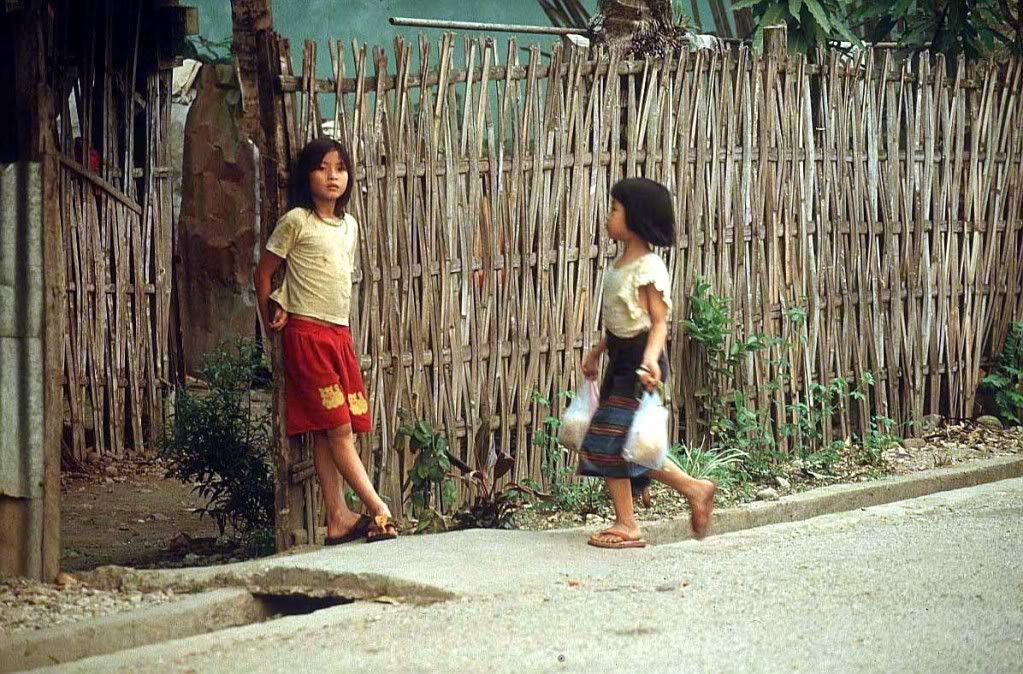 Others are evocative of neighboring lands-the Shan
Nawab of Burma, and the Tawny Rajah of Assam.
Perhaps the most appealing feature of Laos is its
relative lack of development. Resorts and tourist
attractions flourish already, but they do not
overwhelm.
Between each such development large areas of natural
forest still thrive, and one has only to turn aside
and walk for a few hundred yards into the surrounding
hills to be aware of the original, pristine beauty of
the place. Happily. local developers seem to be aware
of this fact and seek to limit the uncontrolled
exploitation seen so widely elsewhere. Natural beauty
and charm are the secret of Laos appeal, and the key to
its continuing prosperity.
Others are evocative of neighboring lands-the Shan
Nawab of Burma, and the Tawny Rajah of Assam.
Perhaps the most appealing feature of Laos is its
relative lack of development. Resorts and tourist
attractions flourish already, but they do not
overwhelm.
Between each such development large areas of natural
forest still thrive, and one has only to turn aside
and walk for a few hundred yards into the surrounding
hills to be aware of the original, pristine beauty of
the place. Happily. local developers seem to be aware
of this fact and seek to limit the uncontrolled
exploitation seen so widely elsewhere. Natural beauty
and charm are the secret of Laos appeal, and the key to
its continuing prosperity.
If you are not already bored and sleepy, my dog
and I like to invite you to see some more pictures on
the next pages. If you know how much troubles it cost
to me to "create" only a blank page you will not even
doubt not to see the next beauty of Laos.
